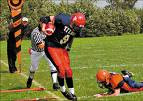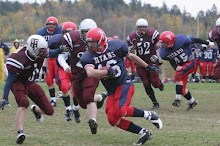Football blocking rules vary from coach to coach. Basically, the type of offence you run and the football players you have on your roster will usually determine the blocking rules that you use. My experience with youth football blocking rules is to keep it simple as the sky is the limit as far as blocking rules in football are concerned.
At the younger youth football levels I like to coach up what I call " Straight up Blocking". In the straight up blocking system your players will be taught a shoulder drive blocking technique. Basically, they learn to step towards the defender with their near foot, keep their head on the playside of the defender,and drive the defender away from the running hole, using their shoulder as point of contact to drive their man out of the running lane. Now some coaches at the youth football level don't like the shoulder drive block for whatever reasons but I have found that it is simple and an effective technique to teach our youth football players. Once they learn how to drive block in practice the next step would be to coach them up in how to double team using the same shoulder block technique.
Once they are fundamentally sound on the shoulder drive block technique we teach them their basic football blocking rules. Now the blocking rules are fairly simple to follow and lets remember now that at the youth football level the simpler, the better! Our blocking rules are three words: Inside Gap,On, Over or to make it simple we call it "Goo" blocking. Now in Goo blocking its important first of all that your offensive linemen know where the ball is going. In other words what hole you are running the ball through. Once thats established the offensive linemen will apply his blocking rules knowing first of all where the ball is going and then secondly checking the alignement of the defensive front and applying the football blocking rules in relation to where the defence is lining up. The offensive linemen is coached up in the "goo" blocking scheme to make sure that his head is always in the hole. So once the play is called in the huddle, the offensive linemen lines up on the line of scrimmage and begins to apply is basic blocking rules. First of all, he checks to see if a defender is aligned on his "inside gap". If there is a defender in this gap then that is his man to block. If there is no defender in that gap,then, he checks off the second part of the football blocking rules which is "On". Now if there is a defender aligned right on him, down in a stance on the line of scrimmage then he knows that this is his man to block, again keeping in mind to keep his head on the playside of the defender. If there is no defender "on" him then he refers to his final rule and that is " Over". Now in " over" the defender would probably be the linebacker. This would be his man to block!
Again, football blocking rules are like any football system. That is, they are the personal philosophy of the coach that is implementing them. We all have our own preferences of what football blocking rules should be and this is just one example.
Cheers!
At the younger youth football levels I like to coach up what I call " Straight up Blocking". In the straight up blocking system your players will be taught a shoulder drive blocking technique. Basically, they learn to step towards the defender with their near foot, keep their head on the playside of the defender,and drive the defender away from the running hole, using their shoulder as point of contact to drive their man out of the running lane. Now some coaches at the youth football level don't like the shoulder drive block for whatever reasons but I have found that it is simple and an effective technique to teach our youth football players. Once they learn how to drive block in practice the next step would be to coach them up in how to double team using the same shoulder block technique.
Once they are fundamentally sound on the shoulder drive block technique we teach them their basic football blocking rules. Now the blocking rules are fairly simple to follow and lets remember now that at the youth football level the simpler, the better! Our blocking rules are three words: Inside Gap,On, Over or to make it simple we call it "Goo" blocking. Now in Goo blocking its important first of all that your offensive linemen know where the ball is going. In other words what hole you are running the ball through. Once thats established the offensive linemen will apply his blocking rules knowing first of all where the ball is going and then secondly checking the alignement of the defensive front and applying the football blocking rules in relation to where the defence is lining up. The offensive linemen is coached up in the "goo" blocking scheme to make sure that his head is always in the hole. So once the play is called in the huddle, the offensive linemen lines up on the line of scrimmage and begins to apply is basic blocking rules. First of all, he checks to see if a defender is aligned on his "inside gap". If there is a defender in this gap then that is his man to block. If there is no defender in that gap,then, he checks off the second part of the football blocking rules which is "On". Now if there is a defender aligned right on him, down in a stance on the line of scrimmage then he knows that this is his man to block, again keeping in mind to keep his head on the playside of the defender. If there is no defender "on" him then he refers to his final rule and that is " Over". Now in " over" the defender would probably be the linebacker. This would be his man to block!
Again, football blocking rules are like any football system. That is, they are the personal philosophy of the coach that is implementing them. We all have our own preferences of what football blocking rules should be and this is just one example.
Cheers!














